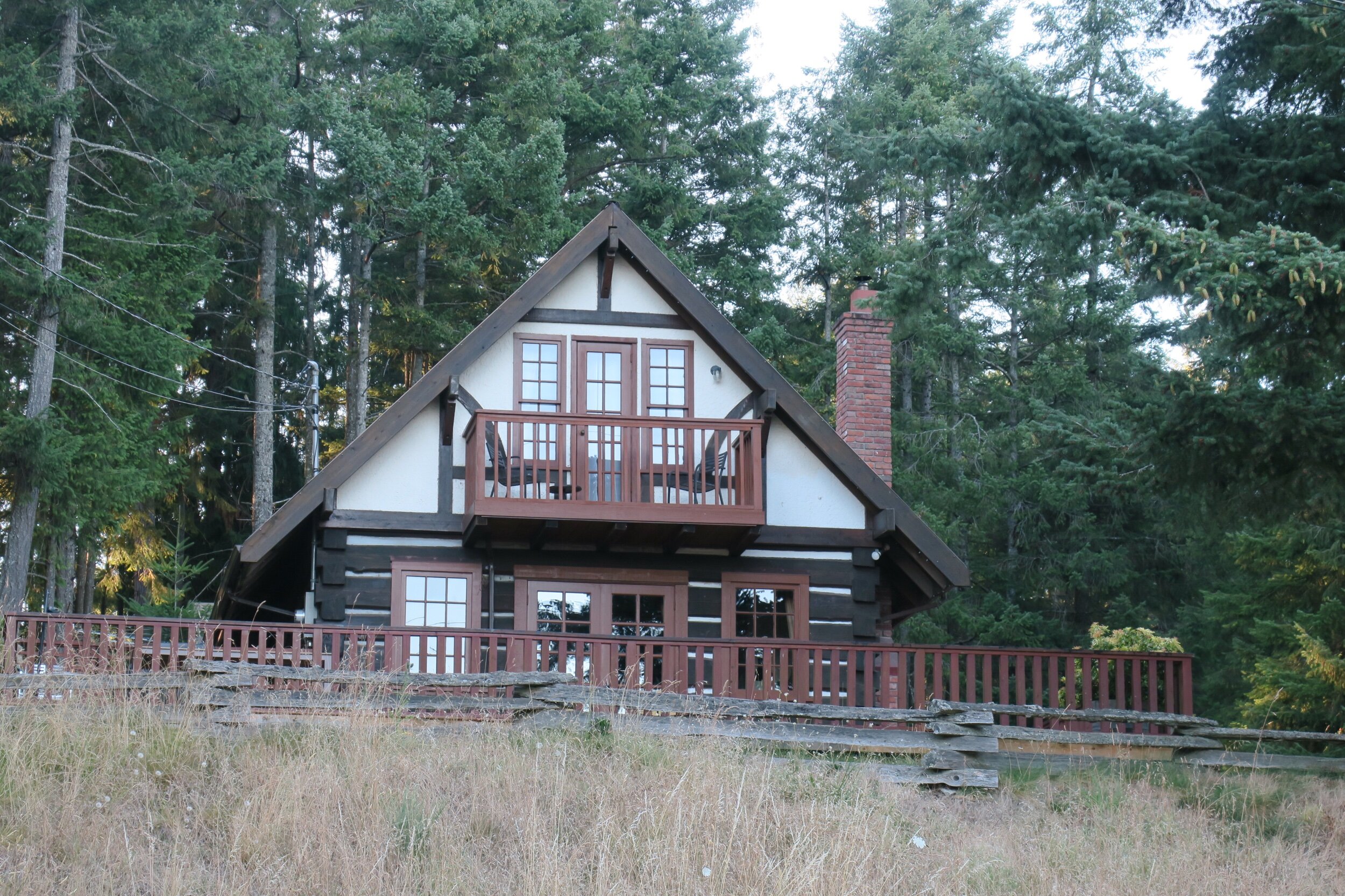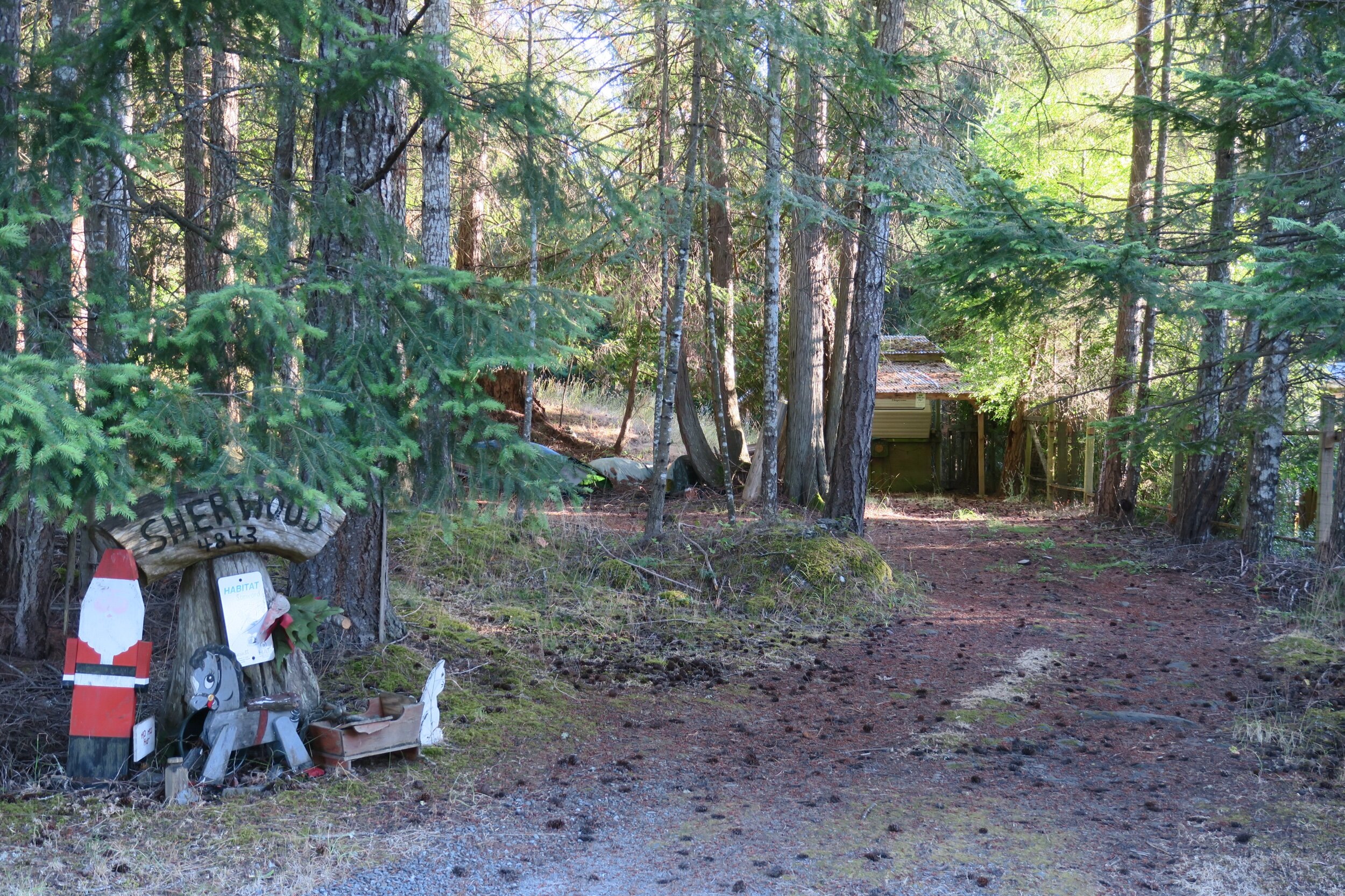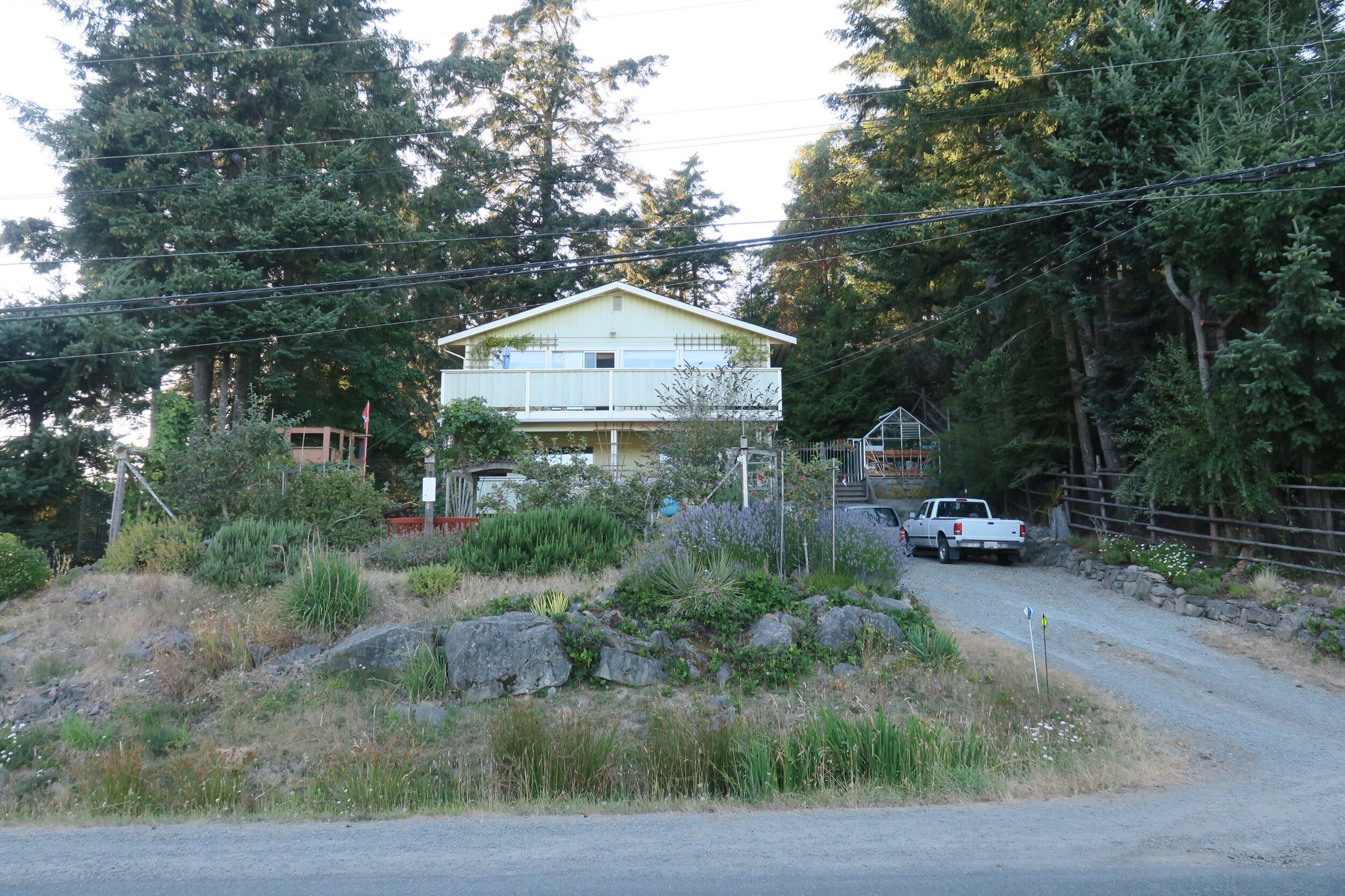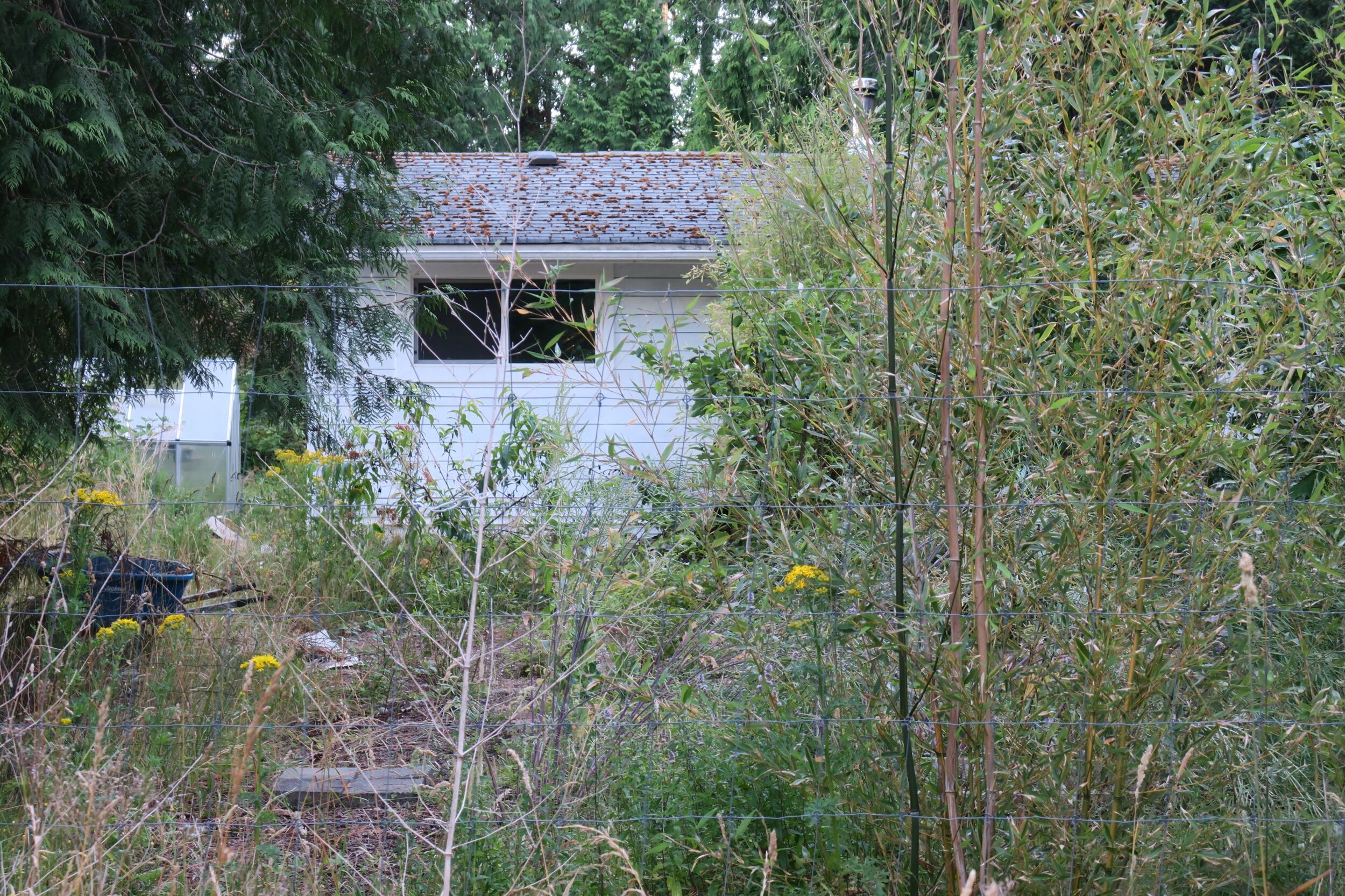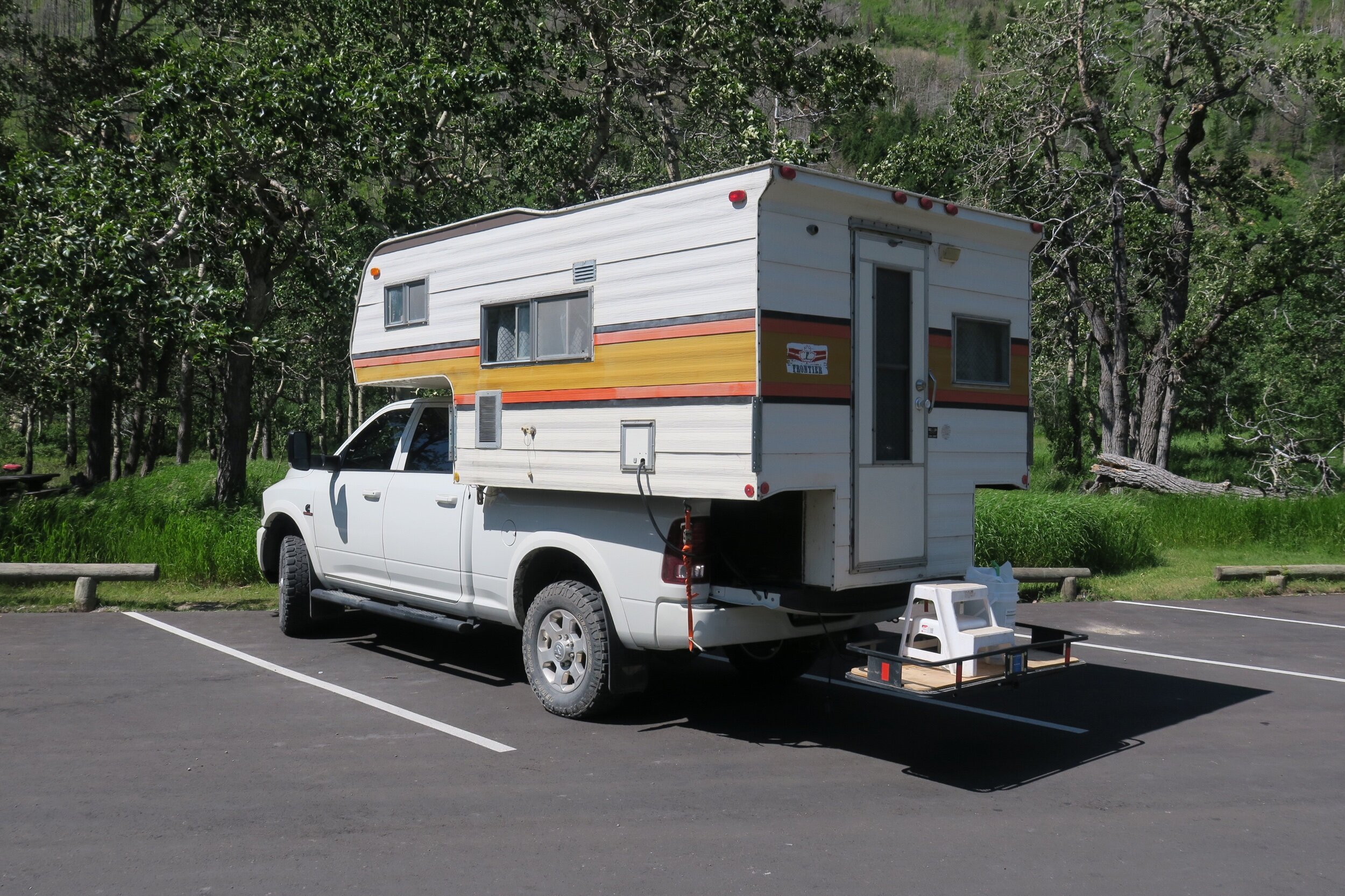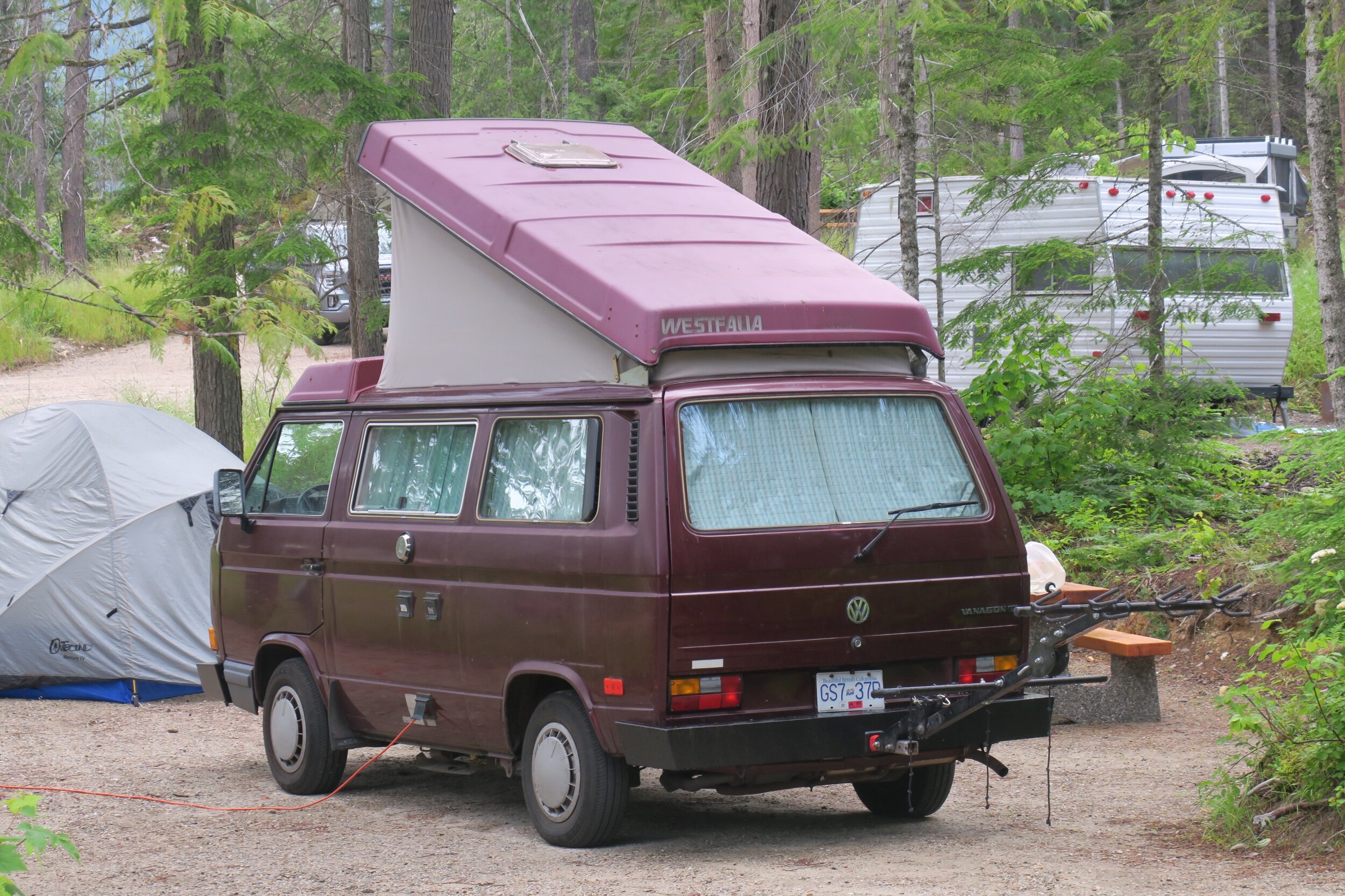The living room renovation is almost done; some pictures from the build are here.
Toronto
10,384 kilometers
38 days
6 national parks
5 roadside motels
4 days of rain
3 days lost to a loose bolt
2 meet ups with friends and family
1 Timmies card worth of small double-doubles
Countless great people
Iron Bridge
The Red Top motor inn is located in Iron Bridge ON and not only is the lodging perfect, they have a good restaurant to takeaway the 20 yards back to the room.
Last 2 days the north shore of Lake Superior has been foggy, cold and wet but never really full on showers. Perfect weather to not take photos..
100,000
Today the ol’ donkey rolled over a hundred thousand klicks - we had a little celebration in the cold fog and rain just outside Marathon ON.
Onwards to 200,000.
Brandon, MB
The techs at Blackfoot Motorrad got things sorted - turned out one of the 6 bolts holding the fuel pump gave up - this caused a fuel leak resulting in donkey running out of gas which was exactly what it felt like.
The homing beacon is on and I’m eastwards on the #1 TCH eating up the kilometers. The lodging is cheap, the riding is tranquil and the view is superb.
Calgary
So the ol’ donkey made it just across the BC-AB border heading to Lake Louise and then conked out and no coaxing would make her go any further.
This is the first mechanical failure on the road for this motorcycle and given the abuse I’ve inflicted over the years it’s pretty remarkable.
Cell phone access is dodgy in the Rockies and I couldn’t complete a call to CAA but a passing motorcyclist was able to make the call (thanks Ducati-Kevin) and soon enough driver Dan was dispatched out of Canmore and taking me to the BMW shop in Calgary with sad bike on the trailer - in part through a hellish thunderstorm with fork lightning and some hail.
Hopefully soon I’ll know what’s what and get outta the outskirts of southern Calgary.
CAA - thanks.
Gulf Islands
Gulf Islands national park reserve is located in the Strait of Georgia - a collection of islands just east of southern Vancouver Island which experience Mediterranean type weather - warm and dry in the summer and mild and wet in the winter.
The park was formed in 2003 to protect the area’s unique ecosystem, which is rich with ecologically diverse plants and sea-life. It covers more than 15 islands and provides representation of the Strait of Georgia Lowlands natural region.
The Prior Centennial campground is on North Pender island. From the campground you can follow the Heart Trail which leads to the Magic Lake Estates:
Magic Lake Estates was developed in the 1960s by carving up 600 acres into 1200 1/2 acre plots in a subdivision on the west side of North Pender island.
Here are some of the cottages:
A few more random shots.
Very nice place. If you can stand the weather.
Some Rigs Are Bigger Than Others
Revelstoke
Mount Revelstoke national park was formed in 1914 and is situated just west of Glacier park and also features a ton o’ hikes. The Snowforest campground is brand new this year and is situated in the hills above the town of Revelstoke.
The new campground is very swish and a short walkable distance from town.
They were just completing three MicrOcubes which are 10 m^2 boxes with lighting, a double bed, gas bbq out front and big windows facing the forest.
Beyond the campground is the Meadows In The Sky parkway which climbs 1800 metres in 26 km with 16 switchbacks (marked at 20 km/hr and you’d best believe it) as well as excellent pavement - a dream on 2 wheels. The bicyclists really, really have to work for their exhilaration on the way down. Here’s view from the top:
A view of the Columbia River from a lookout partway up:
Revelstoke below:
One of the few straight sections on the Meadows In The Sky parkway:
Wanna go for a hike and finish at a brew pub in town? Revelstoke. Wanna go for a hike and byob to a campground in the mountains? Glacier. They’re 50 km apart. Visit both ffs.
Glacier
Glacier national park is centered on Rogers pass - it was formed in 1886 at the completion of the railway. It contains the Rogers pass national historic site with camping spots nearby.
Unlike the spiral tunnels in Yoho, the approach to gain elevation in Rogers pass was to use massive figure-eight looping trestle bridges, the remains of which can be seen on a short hike from the campsite.
She was in the tree keeping watch on my site:
During railway construction, the folks at CP rail found it too expensive to haul the heavy dining cars up Rogers pass, so they built Glacier lodge to feed the passengers before heading up the pass. The hotel soon attracted hikers from around the world - it operated from 1887 to 1925. Here is a shot from the early stages of the Asulkan trail which leaves from the Illecillewaet camp ground and the ruins of the Glacier hotel - there’s hours of hiking ahead.
This would be an awesome place to hang out for a few days - the parks hiking guide lists 18 day hikes which end in alpine meadows, glaciers and ridges, some of which date back to the turn of the century. Spectacular park.
Yoho
Yoho national park office is located in the small town of Field BC.
The campsite is just outside town on the road leading up to Takakkaw falls. The falls have a total height of 373 metres (with a main drop of 254 metres) making it the 2nd tallest waterfall in Canada. Takakkaw translates to "wonderful" in Cree.
Yoho is also home to the CP spiral tunnels carrying trains through the mountains to gain elevation through Kicking Horse pass - based on a Swiss design. Train nuts love this stuff - it was designated a national historic site in 1971.
Kootenay
The drive from Waterton to Kootenay has a long stretch of flatland with looming Rockies - this route (highway #3) follows Crowsnest pass into the mountains.
The parks office for Kootenay is located on the edge of the village of Radium Hot Springs - the campsite is about 3 km up in the hills above town.
The drive through the park heads north for about 100 km, enters Banff national park, then heads north and through Kicking Horse pass and Into Yoho national park.
Waterton Lakes
Waterton Lakes is Canada’s 4th national park (established in 1895) - it’s nestled in the south-west corner of Alberta and represents the Southern Rocky Mountains Natural Region. The campsite is on the edge of town, just past the waterfall:
From the campsite it’s a short walk into town which is tiny and bustling with a number of old houses along with a couple blocks with restaurants, coffee shops and touristy stores.
The Prince of Wales hotel (completed in 1929) is in a beautiful spot overlooking the lake and town. It was built during Prohibition so they could ferry passengers up Waterton lake from the US side (it straddles the border), booze them up proper in Canada, and then ferry them back home a few days later - big business until Prohibition was repealed. So it’s an American hotel in a Canadian national park, built in the Swiss style entirely from Douglas fir and called the Prince of Wales (who has never visited) with staff kitted out in tartan and kilts. The hotel also has the oldest working elevator in North America if you’re into that stuff.
The view from the balcony of one of the 4th floor rooms:
Some shots from around town:
Heck, even the RCMP office is nice:
Grasslands
Grasslands national park is in southern Saskatchewan on the border - there is a west and east side. The west side features bison, prairie dogs and rattlesnakes; the east features a Badlands area, bouncing deer, dinosaur artifacts and no snakes. I’m staying at the east side - here is the view from the visitor center:
The Valley of 1000 Devils is a hike through the grasslands which abruptly changes scenery completely:
The recently built Badlands Parkway is the best 12km of pavement in SK and winds past a number of lookout points:
Westwards.
Kenora
Today was an easy drive up highway #11 to Kenora and from here tomorrow the plan is to head west to Saskatchewan - the only stops in Manitoba will be for gas. Some pics from along the way today:
Fort Frances
The north shore of Lake Superior is a fine drive in nice weather but can also be unbelievably nasty if it turns. Aside from a 1/2 hour thunderstorm, all good:
Kekabeka Falls is a provincial park just east of Thunder Bay (the route skirts the city entirely). The name "Kakabeka" comes from the Ojibwa word gakaabikaa meaning “waterfall over a cliff" - the falls on the Kaministiquia River are 40m high and the surrounding area quite lovely.
Campsite 205.
Fort Frances is right across the Rainy River from International Falls Minnesota. It is home to the Canadian Bass fishing championship usually held every July, alas cancelled this year. I was told the other night by a guy from Thunder Bay to take a day off and go fishing in the area - he was pretty adamant. Tony, I didn’t go and get a rod & jigger (or whatever you said) at Canadian Tire like I said I would. I don’t fish.
Rabbit Blanket Lake
Currently at a campsite on Rabbit Blanket Lake which is part is Lake Superior Provincial Park just south is Wawa ON. They have restricted the number of sites and lots of amenities are not available (including drinkable water :-). Tourism in the area is way down - motels and restaurants seem generally open with reduced staff. On way I stopped at a motor inn:
COVID signs everywhere - people playing it safe in tourism country.
First step arriving somewhere is make a cup of Jimmy’s coffee - Hoffa.
Dinner tonight was dehydrated pasta & beef & stuff which ended up a reimagined Hamburger Helper and pretty good.
Sugar Cereal
We discovered to our sadness that 8-pack assorted “weekend” cereal boxes are no longer perforated to make your own bowl-in-a-box.
Also Sugar Pips are inedible, Froot Loops slightly less so. Nobody eats the Corn Flakes.
Silent Passage
Bob Carpenter was born on a reservation near Tamagami ON (he was Half Ojibway) and recorded the tracks for Silent Passage between 1971 and 1974 in both Toronto and LA. A contractual dispute with Warner Brothers caused the LP to be shelved until 1984 when Holger Petersen (head of Stony Plain records) obtained the rights and released it to little acclaim - by this point Carpenter had quit the music business to become a Buddhist monk.
The LP has background vocals by Anne Murray, Emmylou Harris & Dianne Brooks and contributions from Lowell George, Bill Payne, Buddy Cage and others - it was produced by legendary Canadian producer Brian Ahern (who married Harris). Bob Carpenter had been a sailor and there is a nautical theme throughout - the LP cover depicts Gustave Doré’s etching from The Rime of the Ancient Mariner and is evocative of what’s inside.
The arrangements are top notch and his lyrics and voice fit together; think of a world-weary Cat Stevens perhaps. The album was given a lovely re-issue in 2014 on the No Quarter label with liner notes from Brian Ahern. It’s a complete gem of an album and very highly recommended. Here is “Morning Train”:
Northwest Company
In 1966 The Bad Boys, a band out of Haney BC (a suburb of Vancouver) changed name to The Northwest Company and for a while they were one of the most popular bands on the Canadian west coast. The original lineup consisted of Rick McCartey (lead vocals), Ray O'Toole (lead guitar and vocals), Vidor Skofteby (rhythm guitar), Gowan Jurgensen (bass), and Jerry Ringrose (drums). They released a handful of singles but never achieved any chart success and folded in 1973.
Below is a clip from the TV show “Let’s Go” with The Northwest Company playing “Flying On The Ground Is Wrong” which was written by Neil Young and appears on the first Buffalo Springfield album from 1966 - the Guess Who also released it as a single in 1967.






